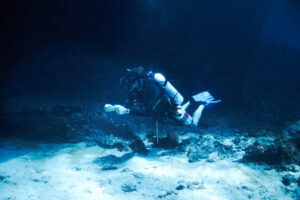What is Bottom Time when Scuba Diving?
Bottom time is an essential concept in scuba diving. Bottom time refers to the time a diver spends submerged underwater, from the descent below the surface until the start of their ascent. It is a critical element in determining the decompression obligation of a diver, ensuring their safety, and minimizing the risk of decompression sickness (DCS). This article will delve into the importance of bottom time when scuba diving, how it is calculated, and how it influences decompression obligation and dive planning.
Understanding Bottom Time
Bottom time begins when a diver descends below the water’s surface and ends when they start to ascend back to the surface. It does not include the time spent on the ascent itself or the decompression stops required to allow gas bubbles to dissolve safely from the body. The primary reason for tracking bottom time is to calculate the decompression obligation and avoid decompression sickness (DCS), a potentially life-threatening condition.
Decompression sickness, also known as “the bends,” occurs when nitrogen bubbles form in the body’s tissues due to rapid ascent or insufficient decompression. By carefully monitoring bottom time, a diver can ensure that they follow appropriate decompression procedures, preventing the formation of these dangerous bubbles.
Calculating Bottom Time
Bottom time can be calculated using a dive computer, a depth gauge and a timer, or a dive table. Dive computers are the most accurate and convenient tools for tracking bottom time, as they continuously monitor the diver’s depth and time spent underwater. They also provide real-time information on the remaining bottom time based on the current depth and the diver’s nitrogen saturation levels.
When using a depth gauge and timer, the diver must manually track their depth and time underwater to determine their bottom time. This method requires more attention and experience, as it relies on the diver’s ability to accurately monitor and record their dive data.
Dive tables, such as the U.S. Navy Dive Tables or Bühlmann Tables, provide a pre-calculated set of guidelines for divers to follow based on depth and time underwater. These tables simplify the calculation of bottom time and decompression obligation by offering conservative dive profiles, reducing the risk of DCS.
Influence on Decompression Obligation
The decompression obligation is the amount of time a diver must spend at specific depths during their ascent to allow for the safe release of accumulated nitrogen. The longer the bottom time, the greater the decompression obligation will be, as more nitrogen will have dissolved into the diver’s tissues.
Divers must also consider factors like repetitive dives, altitude, and pre-existing medical conditions when calculating their decompression obligation. These factors can increase the risk of decompression sickness (DCS), making it even more critical to accurately track bottom time and plan decompression stops accordingly.
Dive Planning and Bottom Time
Proper dive planning is essential for managing bottom time and ensuring a safe diving experience. Divers should use a combination of dive computers, tables, and personal experience to establish a dive plan that takes into account their bottom time and decompression obligation. Dive plans should include:
The maximum planned depth and bottom time
The maximum planned depth and bottom time directly impact decompression obligation and should be planned conservatively to minimize decompression sickness (DCS) risk.
Decompression stops
Divers must identify the appropriate depths and durations for their decompression stops based on their bottom time and decompression obligation.
Gas supply
Ensuring that enough gas is available for the dive, including extra reserves for emergencies, is crucial. The longer the bottom time, the more gas will be consumed.
Surface interval
This refers to the time spent on the surface between dives. Longer surface intervals allow for more nitrogen off-gassing, reducing the risk of DCS on subsequent dives.
Buddy system
Diving with a buddy ensures that both divers monitor their bottom time and decompression obligation, providing an additional layer of safety and support in case of emergencies.
Environmental factors
Divers should consider factors such as water temperature, visibility, and currents when planning their bottom time, as these can affect the diver’s comfort, safety, and gas consumption.
Personal fitness and experience
A diver’s physical fitness, experience, and familiarity with their equipment can significantly impact their ability to manage bottom time and decompression obligations effectively. Proper training and regular practice are essential for maintaining safe diving habits.
Emergency procedures
Divers should establish contingency plans in case of unexpected situations, such as equipment failure, changes in environmental conditions, or diver illness, which could require adjustments to bottom time or decompression obligations.
Bottom time is a critical component of scuba diving, as it directly influences the decompression obligation and the overall safety of the diver. Accurate monitoring and calculation of bottom time, along with adherence to conservative dive planning principles, are crucial in minimizing the risk of decompression sickness and ensuring a safe and enjoyable diving experience. By understanding the importance of bottom time and incorporating it into their dive planning, divers can explore the underwater world with greater confidence and security.

















